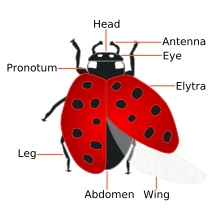Coccinellidae
Coccinellidae (/ˌkɒksɪˈnɛlɪˌdiː/)[3] is a widespread family of small beetles ranging in size from 0.8 to 18 mm (0.03 to 0.71 in).[4] The family is commonly known as ladybugs in North America and ladybirds in Great Britain and other parts of the English-speaking world. Entomologists prefer the names ladybird beetles or lady beetles as these insects are not classified as true bugs.[5]
The majority of coccinellid species are generally considered beneficial insects, because many species prey on herbivorous hemipterans such as aphids or scale insects, which are agricultural pests. Many coccinellids lay their eggs directly in aphid and scale insect colonies in order to ensure their larvae have an immediate food source.[6] However, some species do have unwelcome effects; among these, the most prominent are of the subfamily Epilachninae (which includes the Mexican bean beetle), which are herbivorous themselves. Usually, epilachnines are only minor agricultural pests, eating the leaves of grain, potatoes, beans, and various other crops, but their numbers can increase exponentially in years when their natural enemies, such as parasitoid wasps that attack their eggs, are in fewer numbers. In such situations, they can do major crop damage. They occur in practically all the major crop-producing regions of temperate and tropical countries.
The name coccinellids is derived from the Latin word coccineus meaning "scarlet".[7] The name "ladybird" originated in Britain where the insects became known as "Our Lady's bird" or the Lady beetle.[8][9] Mary (Our Lady) was often depicted wearing a red cloak in early paintings, and the spots of the seven-spot ladybird (the most common in Europe) were said to symbolise her seven joys and seven sorrows.[8][10] In the United States, the name was adapted to "ladybug". Common names in some other European languages share associations; for example, the German name Marienkäfer translates to Marybeetle.[11]
Coccinellids are often conspicuously coloured yellow, orange, or red with small black spots on their wing covers, with black legs, heads and antennae. There is, however, great variation in these colour patterns. For example, a minority of species, such as Vibidia duodecimguttata, a twelve-spotted species, have whitish spots on a brown background. Coccinellids are found worldwide, with over 6,000 species described.[12][4]
Most coccinellids have round to elliptical, dome-shaped bodies with six short legs. Depending on the species, they can have spots, stripes, or no markings at all. Seven-spotted coccinellids are red or orange with three spots on each side and one in the middle; they have a black head with white patches on each side.
As well as the usual yellow and deep red colourings, many coccinellid species are mostly, or entirely, black, dark grey, gray, or brown, and may be difficult for non-entomologists to recognise as coccinellids at all. Conversely, non-entomologists might easily mistake many other small beetles for coccinellids. For example, the tortoise beetles, like the ladybird beetles, look similar because they are shaped so that they can cling to a flat surface so closely that ants and many other enemies cannot grip them.[citation needed]




